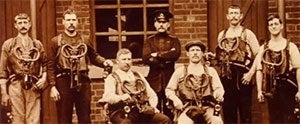Over the years, work in confined spaces resulted in several fatalities and injuries to workers across a range of industries. This led to the introduction of the Confined Space Regulations 1997, designed to remove the risk of fatalities to persons who may need to work in such spaces. However, sadly, despite these regulations, around 15 people in the UK are still killed in confined spaces incidents each year. These deaths occur either because of an inability to recognise the confined space and its dangers, ill-conceived rescue attempts or inadequate systems for safe working.
Understanding the risks, Sapphire Utilities, in conjunction with United Utilities, undertook an investigation into reviewing the ongoing low and medium risk activity taking place by workers inspecting and cleaning the network of Victorian manholes throughout the UK. United Utilities has many thousands of these ‘legacy’ manholes within their asset base, and although constructed to an excellent standard, prove a huge issue for modern day water companies, as they were not ‘future proofed, and the Victorian contactors using them then did not have safety equipment obstructing access and egress.
The need
United Utilities is investing millions of pounds into their Dynamic Network Management project in order that they can reduce or remove network issues in a proactive manner. As part of the project monitors needed to be installed into these manholes to provide live network information to the company on a real time basis.
As experts in confined spaces, MRS Training & Rescue, together with Sapphire Utilities, conducted a technical study of manhole access and egress activities into the common opening sizes of manholes found in and around the United Utilities’ area of operations.
What we did
Exercises were undertaken involving the entry and escape of persons of differing size and dynamic into manhole chamber sizes which fall below that which all personnel are historically trained for. This manhole exercise was carried out over two separate days in November 2021.
Many of the Victorian manholes are well below the minimum size of 575mm diameter required by the Confined Space regulations, to allow access with full rescue facilities including self-contained breathing apparatus – as per Appendix 2 of the Confined Space Regulations 1997.
We set up our equipment at seven locations, all with chamber entry sizes in ever decreasing sizes between the 575 mm and 450 mm dimensions.
One of our operatives was 5’6” (1.68m) and 10st 5lb (66kg) – the second was 5’11” (1.8m) and 16st 7lb (105kg). These two operatives conducted entry access at each location and then egress the manhole as both self-rescue and assisted rescue (as though unconscious). These egresses were carried out using the harness front loop and then the rear loop to compare effectiveness and issues.
We had a three-person team on site in case an actual rescue was required from the live sewer during the exercise. However, for the purpose of the exercise only one top person was allowed to physically operate during access and egress activities. The second top man was only there to observe the exercise and act accordingly as the third person if a live rescue was required on site.
The results
These exercises confirmed that any chamber size less than 575 x 575 mm causes complications with an operative’s access and egress activities within a confined space.
In most cases (with the smaller operative) and all cases (with the larger operative) it was impossible to access the chamber wearing the Drager CF10 Escape Set. Access was only made possible by the top-person lowering the CF10 down to the operative once access to the chamber had taken place. However, during self-rescue, egress was difficult for the smaller operative as he needed to raise the CF10 above his head whilst climbing upwards. And once within reach of a top person, assistance had to be provided to lift the CF10 out of the operative’s way to climb out of the manhole. This was made far more difficult if the chamber was deep (more than 3 metres). This self-rescue activity was even more difficult (almost impossible) for the larger operative. The exercises showed that if one dimension is greater than 575mm then there is a slight possibility of the operative lifting the CF10 above him as he climbed upwards - once within reach of a top person he could receive the necessary assistance to lift the CF10 clear and allow them to climb out of the manhole. But if both manhole dimensions are less than 550mm then there is little chance of the larger operative egressing the chamber whilst wearing the CF10.
In the case of assisted rescue (unconscious operative), the exercises showed that it did not matter whether the operative was large or small – neither could egress the chamber with the CF10 attached. The top man must raise the unconscious operative to a height and position whereby they could raise at least one of the operative’s arms to make their body narrower and try and raise them to ground level. In most cases this was not possible as the CF10 snagged on step irons or the cover slab. Alternatively, the exercises found that the CF10 pushes the operative’s body over to one side and subsequently the head, shoulders or thighs become wedged against the cover slab or step irons preventing the operative from being winched any further towards ground level. The ‘best case scenario’ with regards to assisted rescue is that the top person can raise the operative to a suitable level where they are able to cut the strap on the CF10 and release it from the operative’s body. This would hopefully provide the necessary space to allow the winching process to ground level.
During the exercises we also found that it is not just the chamber opening size that is important but also the physical layout of the chamber. We found many instances where the area below ground was narrower than the entry point and in many cases the entry point is well below the minimum size outlined in the Confined Space regulations.
Next steps
Sub section 69 of the Confined Space Regulations states that you should assess the requirements for emergency rescue arrangements. Emergencies should be anticipated, and appropriate rescue arrangements made. The risks, and therefore the equipment and measures needed for a rescue by nearby employees, must be identified and the equipment made available for use.
Due to the demographic of the chambers within the Victorian manholes, if an unconscious casualty needed to be brought to the surface, a three-person confined space rescue team (two top people and a third operative to enter manhole), must be on standby to assist. Regardless of whether the activity is classed as low or medium risk, the exercises proved that workers are unable to get out safely and could not egress even when using the services of a top person.
We have interrogated the utility company standards for working in confined spaces and found them to be wanting. To provide assurance to all utility workers, a fully trained in house or third-party rescue service, with all the necessary equipment, must be on hand for anyone working in narrow manholes and chambers. We used the services of MRS Training & Rescue to complete these exercises as we hold them in high esteem as one of the most respected organisations in Europe for confined space expertise. The work they did was invaluable in demonstrating the risks to workers and the safety measures that must be put in place with immediate effect.







